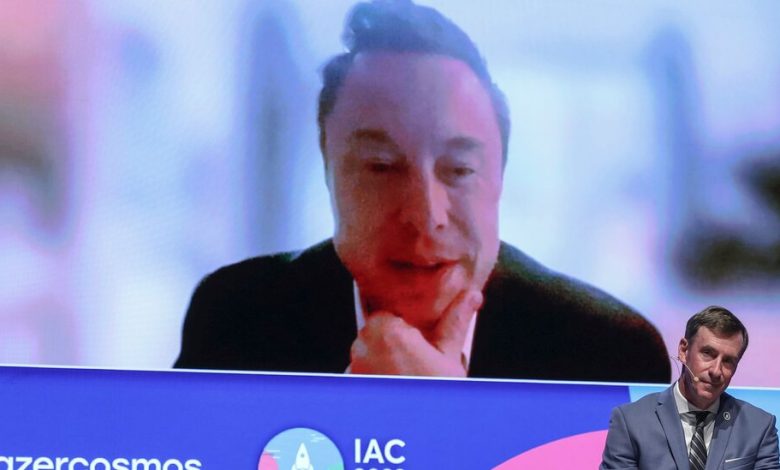Elon Musk Says SpaceX Could Land on Mars in 3 to 4 Years

The Latest
Elon Musk, the founder of SpaceX, said the company could land a spacecraft on Mars three to four years from now.
The suggestion was made as Mr. Musk appeared via videoconference on Thursday at the International Astronautical Congress in Azerbaijan, along with other tidbits on the progress of Starship, a gargantuan rocket that SpaceX is developing.

Elon Musk spoke via video link to Clay Mowry, president of the International Astronautical Federation, in Baku, Azerbaijan, on Thursday.Credit…Roman Ismayilov/EPA, via Shutterstock
Quotable Quote: On getting to Mars.
”I think it’s sort of feasible within the next four years to do an uncrewed test landing there,” Mr. Musk told Clay Mowry, the president of the International Astronautical Federation during a one-hour question-and-answer session.
A Year That Sums It Up: 2022.
Mr. Musk and SpaceX have a strong track record of achieving remarkable breakthroughs in spaceflight. That includes the routine landing and reuse of the booster stages of SpaceX’s current Falcon 9 rockets: The company has launched 70 times this year alone.
But Mr. Musk has another track record: taking far longer than predicted to achieve his goals.
Mr. Musk first unveiled his Mars rocket, then an even larger rocket called the Interplanetary Transport System, at an International Astronautical Congress in Guadalajara, Mexico, in 2016. He predicted that SpaceX’s first uncrewed landing on the red planet would occur in 2022, followed by the first flight with people aboard in 2024.
So far, there has been one test flight of Starship, in April, which made it off the launchpad before it spun out of control and an order was given to detonate the vehicle several minutes into its flight.
A second Starship is ready, Mr. Musk has said. But SpaceX is still waiting for the Federal Aviation Administration to issue a new launch license, possibly as soon as this month.
On Thursday, Mr. Musk described some of the changes in the evolving design of Starship. On the second flight, the engines of the second stage will ignite before it separates from the booster. The maneuver, known as “hot staging,” can be tricky.
“You’re essentially blasting the top of the booster” with the second-stage engines, Mr. Musk said. “This is actually, from a physics standpoint, the most efficient way.”
Mr. Musk is no longer predicting to put humans on Mars in 2024, but he has other technologically ambitious predictions for Starship next year. For speedy turnaround between launches, SpaceX plans for the rocket’s Super Heavy booster to not only return to its launch site, but to also hover about the ground as two arms on the launch tower catch it in midair. The same maneuver would be used for the Starship upper stage when it returns from orbit.
Mr. Musk said there was “a decent chance” of catching a booster within the next year and possibly a Starship from orbit before the end of next year.
Mr. Musk also said that SpaceX’s next-generation of Starlink satellites could start going up next year on expendable versions of the Starship stage that are not reused.
What Wasn’t Said: When will Starship land NASA astronauts on the moon?
The conversation between Mr. Mowry and Mr. Musk just briefly touched on SpaceX’s key role in Artemis, NASA’s program to send astronauts back to the moon. A version of Starship is to take two NASA astronauts from orbit around the moon to a landing in the south pole region during the Artemis III mission.
“You’re doing a lunar lander version, yes?” Mr. Mowry said.
Mr. Musk acknowledged that, but pivoted to saying that what SpaceX was building for NASA would include only minor modifications from a spacecraft designed to land on Mars.
Artemis III is currently scheduled for late 2025, but NASA officials have suggested that date is likely to slip into 2026, at least.
A couple of months ago, James Free, NASA’s associate administrator for exploration systems development, said NASA had received an updated schedule for Starship development and was reviewing it.
Without singling out SpaceX, Mr. Free said in August that if not all the technological pieces were ready for a moon landing, “we may end up flying a different mission.”





